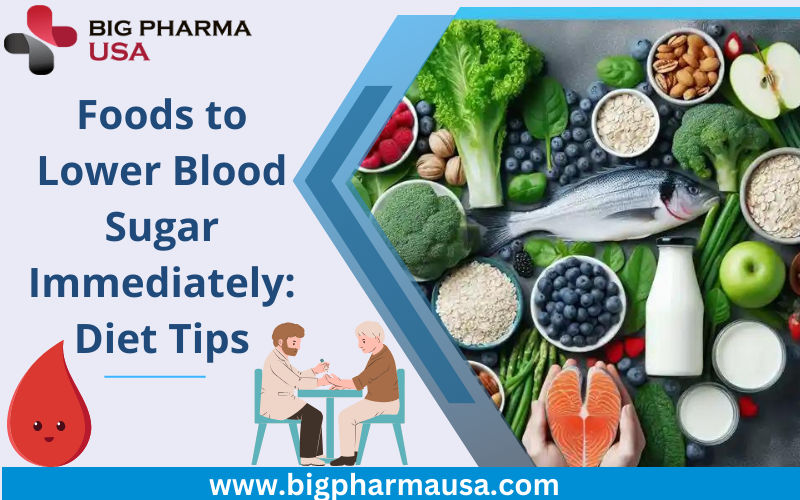Lower blood sugar levels can cause diabetes which is a disease that can create an imbalance in the body’s blood sugar levels. It occurs when the body either does not have enough insulin or the insulin is not used up the way it should. This results in having excess sugar in the bloodstream which causes major health problems.
Although, many factors such as activity, body weight, genetics, etc., play a role in regulating blood sugar levels, following a healthy balanced diet plan is important for blood sugar management.
10 Foods To Lower Blood Sugar Levels Effectively
It is important to eat foods that would not cause blood sugar to spike in the body. Listed below are 10 foods that would help you lower and maintain blood sugar levels effectively.
1. Green Leafy Vegetables
Leafy greens are rich in vitamins A, C, and K as well as minerals like calcium and iron. They have less carbs and more fibre content which aids blood sugar control. If you are looking for a quick recipe try adding spinach into your sandwiches and kale into a bean or veggie soup or salad.
2. Non-Starch Vegetables
Non-starch vegetables are low in carbs, rich in fibre and beneficial for blood sugar. These veggies have a lot of fibre so it would not cause a spike in blood sugar.
Some examples of non-starchy vegetables are:
- Mushrooms
- Broccoli
- Onions
- Zucchini
- Brussels sprouts
- Celery
Try mixing a good sautéed vegetable with a combination of onion, zucchini, broccoli and garlic into pasta.
3. Spices
Few spices contain hypoglycaemic effects resulting in them helping to lower blood sugar. Therefore, adding spices to meals might help control the blood sugar levels in the body.
Some hypoglycaemic spices are:
- Turmeric
- Ginger
- Cinnamon
Add cinnamon to oatmeals for breakfast and also drink ginger-turmeric tea once a day.
4. Whole Grains
They are low glycemic index foods. Whole grains are unrefined and consist of the germ and bran of the grain, unlike processed refined grains such as white flour. Whole grains provide fibre, which slows down the release of sugar into the blood.
Common whole-grain foods are:
- Oats
- Whole-grain bread
- Brown rice
- Quinoa
- Amaranth
Whole grains have been proven to improve glycaemic control and insulin sensitivity which helps in keeping the blood sugar levels low. For a quick recipe eat oats paired with toast (whole-grain bread) for breakfast.
5. Low-Glycemic Fruits
People should include fruits in their balanced diet especially those who are suffering from high sugar levels in their blood. Diabetics person should know what fruits to avoid and what fruits are better for them. Low-glycaemic fruits do not spike blood sugar levels even after being sweet. They naturally have a low glycaemic index because of their fibre and fructose content.
A few examples are:
- Pears
- Berries
- Oranges
- Grapefruit
- Apples
Mix these fruits into yoghurt or oatmeal for an evening snack.
6. Healthy Fats
Fats result in slow digestion causing the delay of absorption of carbs in the bloodstream. Including healthy fats in your diet helps you feel fuller for a long period and also keeps blood sugar from spiking.
A few examples are:
- Olive oil
- Seeds (sunflower, flax, pumpkin, chia)
- Avocado
7. Non-Sugar Sweetened Beverages
It is commonly known that sugar-sweetened beverages are unhealthy and particularly unhealthy for individuals trying to control diabetes. The sugar present in sugar-sweetened beverages is refined which immediately increases blood sugar levels unlike the naturally occurring sugar found in several fruits.
Try adding fruits to water to make a naturally sweetened beverage rather than drinking sugar-sweetened beverages. Carbonated water without added sugar is also an option rather than a carbonated beverage with excess sugar.
8. Protein Sources
Similar to fats protein also slows digestion which delays the absorption of carbs in the bloodstream. It keeps you fuller for longer as it takes much more time to break down inside the body.
Examples of protein-rich foods are:
- Quinoa
- Dairy
- Soy products
- Eggs
- Beans and rice
Eat quinoa rice and beans for a high-protein dinner and boiled eggs for a snack.
9. Legumes
Legumes have a low glycaemic index and are dense in nutrients. They are great for diabetic-conscious meals. They are rich in fibre which helps to keep blood sugar low.
Some examples of legumes are:
- Beans
- Lentils
- Chickpeas
- Peas
Try drinking lentil soup and chickpea hummus to dip your vegetables into.
10. Nuts
Nuts contain polyunsaturated and mono-saturated fats (unsaturated fats) which come under the category of healthy fats. Researches prove that unsaturated fatty acids play a major part in controlling blood sugar in diabetic patients.
Some examples of nuts are:
- Peanuts
- Walnuts
- Almonds
- Pecans
- Pistachios
Try eating peanut butter with whole-grain bread and add walnuts or pecans to oatmeal.
Conclusion
Following a healthy diet plan is necessary for optimal blood sugar management. If you want to reduce the risk of developing diabetes, adding these foods mentioned above to your diet may help lower blood sugar levels in the body.
Also, remember that not only your diet but other factors such as body weight, stress, and activity level are important to optimize your blood sugar. It’s recommended to consult a licensed healthcare professional for a better and more detailed diet plan according to your body.













